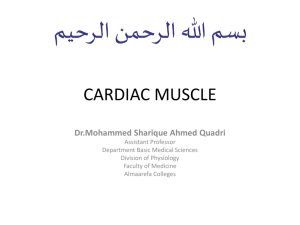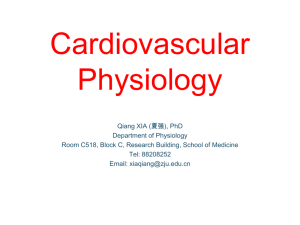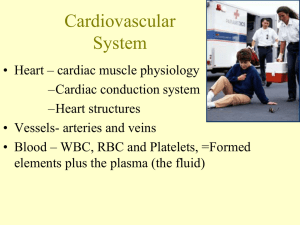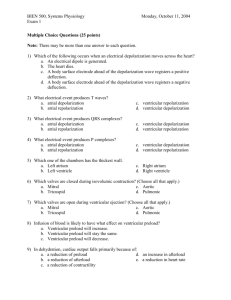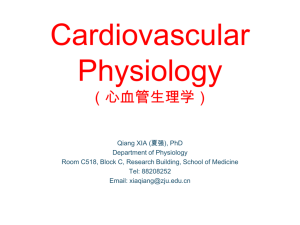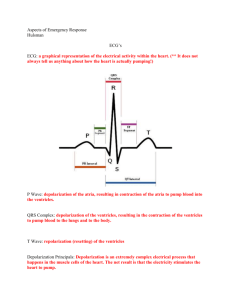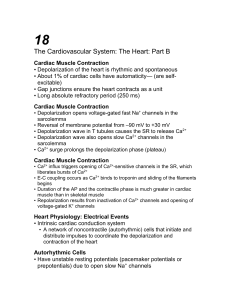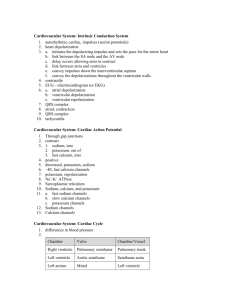Heart rate
advertisement
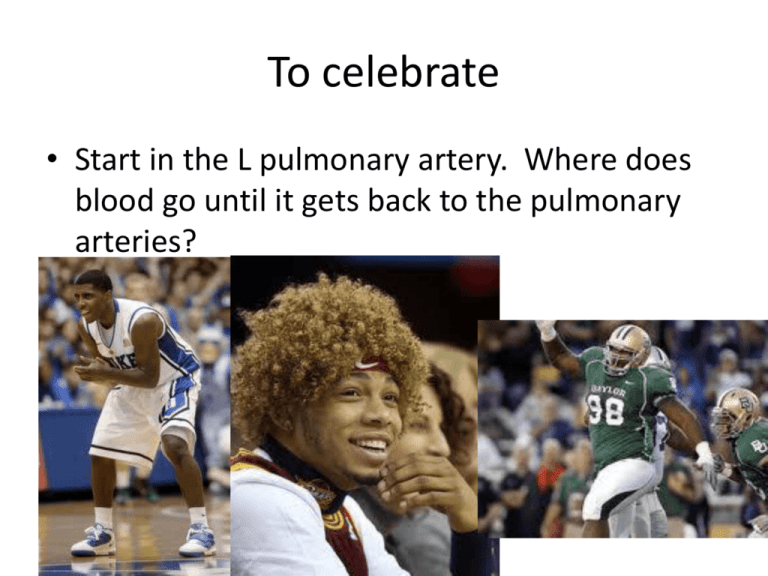
To celebrate • Start in the L pulmonary artery. Where does blood go until it gets back to the pulmonary arteries? Cardiac Muscle Contraction • Depolarization of the heart is rhythmic and spontaneous • About 1% of cardiac cells have automaticity— (are self-excitable) • Gap junctions ensure the heart contracts as a unit • Long absolute refractory period (250 ms) Heart Physiology: Sequence of Excitation 1. Sinoatrial (SA) node (pacemaker) – Generates impulses – Depolarizes faster than any other part of the myocardium Heart Physiology: Sequence of Excitation 2. Atrioventricular (AV) node – Smaller diameter fibers; fewer gap junctions – This Delays impulses approximately 0.1 second – Depolarizes slower in absence of SA node input Heart Physiology: Sequence of Excitation 3. Atrioventricular (AV) bundle (bundle of His) – Only electrical connection between the atria and ventricles Heart Physiology: Sequence of Excitation 4. Right and left bundle branches – Two pathways in the interventricular septum that carry the impulses toward the apex of the heart Heart Physiology: Sequence of Excitation 5. Purkinje fibers – Complete the pathway into the apex and ventricular walls – AV bundle and Purkinje fibers depolarize only 30 times per minute in absence of AV node input Superior vena cava Right atrium 1 The sinoatrial (SA) node (pacemaker) generates impulses. Internodal pathway 2 The impulses pause (0.1 s) at the atrioventricular (AV) node. 3 The atrioventricular (AV) bundle connects the atria to the ventricles. 4 The bundle branches conduct the impulses through the interventricular septum. 5 The Purkinje fibers Left atrium Purkinje fibers Interventricular septum depolarize the contractile cells of both ventricles. (a) Anatomy of the intrinsic conduction system showing the sequence of electrical excitation Figure 18.14a Homeostatic Imbalances • Defects in the intrinsic conduction system may result in 1. Arrhythmias: irregular heart rhythms 2. Uncoordinated atrial and ventricular contractions 3. Fibrillation: rapid, irregular contractions; useless for pumping blood Electrocardiography • • Electrocardiogram (ECG or EKG): a combination of all the APs generated by nodal and contractile cells at a given time 3 waves 1. P wave: depolarization of SA node 2. QRS complex: ventricular depolarization 3. T wave: ventricular repolarization QRS complex Sinoatrial node Atrial depolarization Ventricular depolarization Ventricular repolarization Atrioventricular node P-Q Interval S-T Segment Q-T Interval Figure 18.16 R SA node Depolarization Repolarization T P 1 Q S Atrial depolarization, initiated by the SA node, causes the P wave. Figure 18.17, step 1 R SA node Depolarization Repolarization T P Q S 1 Atrial depolarization, initiated by the SA node, causes the P wave. R AV node T P Q 2 S With atrial depolarization complete, the impulse is delayed at the AV node. Figure 18.17, step 2 R SA node Depolarization Repolarization T P Q S 1 Atrial depolarization, initiated by the SA node, causes the P wave. R AV node T P Q 2 S With atrial depolarization complete, the impulse is delayed at the AV node. R T P Q S 3 Ventricular depolarization begins at apex, causing the QRS complex. Atrial repolarization occurs. Figure 18.17, step 3 Depolarization Repolarization R T P Q 4 S Ventricular depolarization is complete. Figure 18.17, step 4 Depolarization Repolarization R T P Q 4 S Ventricular depolarization is complete. R T P Q 5 S Ventricular repolarization begins at apex, causing the T wave. Figure 18.17, step 5 Depolarization Repolarization R T P Q 4 S Ventricular depolarization is complete. R T P Q 5 S Ventricular repolarization begins at apex, causing the T wave. R T P Q 6 S Ventricular repolarization is complete. Figure 18.17, step 6 SA node Depolarization R Repolarization R T P S 1 Atrial depolarization, initiated by the SA node, causes the P wave. R AV node T P Q Q S 4 Ventricular depolarization is complete. R T P T P Q S 2 With atrial depolarization complete, the impulse is delayed at the AV node. R Q S 5 Ventricular repolarization begins at apex, causing the T wave. R T P T P Q S 3 Ventricular depolarization begins at apex, causing the QRS complex. Atrial repolarization occurs. Q S 6 Ventricular repolarization is complete. Figure 18.17 SA node Depolarization R Repolarization R T P S 1 Atrial depolarization, initiated by the SA node, causes the P wave. R AV node T P Q Q S 4 Ventricular depolarization is complete. R T P T P Q S 2 With atrial depolarization complete, the impulse is delayed at the AV node. R Q S 5 Ventricular repolarization begins at apex, causing the T wave. R T P T P Q S 3 Ventricular depolarization begins at apex, causing the QRS complex. Atrial repolarization occurs. Q S 6 Ventricular repolarization is complete. Figure 18.17 (a) Normal sinus rhythm. (b) Junctional rhythm. The SA node is nonfunctional, P waves are absent, and heart is paced by the AV node at 40 - 60 beats/min. (c) Second-degree heart block. (d) Ventricular fibrillation. These chaotic, grossly irregular ECG Some P waves are not conducted deflections are seen in acute through the AV node; hence more heart attack and electrical shock. P than QRS waves are seen. In this tracing, the ratio of P waves to QRS waves is mostly 2:1. Figure 18.18 Heart Sounds • Two sounds (lub-dup) associated with closing of heart valves – First sound occurs as AV valves close and signifies beginning of systole – Second sound occurs when SL valves close at the beginning of ventricular diastole • Heart murmurs: abnormal heart sounds most often indicative of valve problems Aortic valve sounds heard in 2nd intercostal space at right sternal margin Pulmonary valve sounds heard in 2nd intercostal space at left sternal margin Mitral valve sounds heard over heart apex (in 5th intercostal space) in line with middle of clavicle Tricuspid valve sounds typically heard in right sternal margin of 5th intercostal space Figure 18.19 Mechanical Events: The Cardiac Cycle • Cardiac cycle: all events associated with blood flow through the heart during one complete heartbeat – Systole—contraction - maximal pressure – Diastole—relaxation - minimal pressure Phases of the Cardiac Cycle 1. Ventricular filling—takes place in mid-to-late diastole – AV valves are open – 80% of blood passively flows into ventricles – Atrial systole occurs, delivering the remaining 20% – End diastolic volume (EDV): volume of blood in each ventricle at the end of ventricular diastole Phases of the Cardiac Cycle 2. Ventricular systole – – – – Atria relax and ventricles begin to contract Rising ventricular pressure results in closing of AV valves Isovolumetric contraction phase (all valves are closed) In ejection phase, ventricular pressure exceeds pressure in the large arteries, forcing the SL valves open – End systolic volume (ESV): volume of blood remaining in each ventricle Phases of the Cardiac Cycle 3. Isovolumetric relaxation occurs in early diastole – Ventricles relax – Backflow of blood in aorta and pulmonary trunk closes SL valves and causes dicrotic notch (brief rise in aortic pressure) Left heart QRS P Electrocardiogram T 1st Heart sounds P 2nd Pressure (mm Hg) Dicrotic notch Aorta Left ventricle Ventricular volume (ml) Atrial systole Left atrium EDV SV ESV Atrioventricular valves Aortic and pulmonary valves Phase Open Closed Open Closed Open Closed 1 2a 2b 3 1 Left atrium Right atrium Left ventricle Right ventricle Ventricular filling Atrial contraction 1 Ventricular filling (mid-to-late diastole) Isovolumetric contraction phase 2a Ventricular ejection phase 2b Ventricular systole (atria in diastole) Isovolumetric relaxation 3 Ventricular filling Early diastole Figure 18.20 Cardiac Output (CO) • Volume of blood pumped by each ventricle in one minute • CO = heart rate (HR) x stroke volume (SV) – HR = number of beats per minute – SV = volume of blood pumped out by a ventricle with each beat Cardiac Output (CO) • At rest – CO (ml/min) = HR (75 beats/min) SV (70 ml/beat) = 5.25 L/min – Maximal CO is 4–5 times resting CO in nonathletic people – Maximal CO may reach 35 L/min in trained athletes – Cardiac reserve: difference between resting and maximal CO Regulation of Stroke Volume • SV = EDV – ESV • Three main factors affect SV – Preload – Contractility – Afterload Regulation of Stroke Volume • Preload: degree of stretch of cardiac muscle cells before they contract (Frank-Starling law of the heart) – Cardiac muscle exhibits a length-tension relationship – At rest, cardiac muscle cells are shorter than optimal length – Slow heartbeat and exercise increase venous return – Increased venous return distends (stretches) the ventricles and increases contraction force Regulation of Stroke Volume • Contractility: contractile strength at a given muscle length, independent of muscle stretch and EDV • Positive inotropic agents increase contractility – Increased Ca2+ influx due to sympathetic stimulation – Hormones (thyroxine, glucagon, and epinephrine) • Negative inotropic agents decrease contractility – Acidosis – Increased extracellular K+ – Calcium channel blockers Extracellular fluid Norepinephrine Adenylate cyclase Ca2+ b1-Adrenergic receptor G protein (Gs) Ca2+ channel ATP is converted Cytoplasm to cAMP a GDP Inactive protein kinase A Enhanced actin-myosin interaction Troponin Cardiac muscle force and velocity Phosphorylates SR Ca2+ channels, increasing intracellular Ca2+ b release binds Ca2+ to Active Phosphorylates plasma membrane Ca2+ channels, increasing extracellular Ca2+ entry protein kinase A Phosphorylates SR Ca2+ pumps, speeding Ca2+ c removal and relaxation Ca2+ Ca2+ uptake pump SR Ca2+ channel Sarcoplasmic reticulum (SR) Figure 18.21 Regulation of Stroke Volume • Afterload: pressure that must be overcome for ventricles to eject blood • Hypertension increases afterload, resulting in increased ESV and reduced SV Regulation of Heart Rate • Positive chronotropic factors increase heart rate • Negative chronotropic factors decrease heart rate Autonomic Nervous System Regulation • Sympathetic nervous system is activated by emotional or physical stressors – Norepinephrine causes the pacemaker to fire more rapidly (and at the same time increases contractility) Autonomic Nervous System Regulation • Parasympathetic nervous system opposes sympathetic effects – Acetylcholine hyperpolarizes pacemaker cells by opening K+ channels • The heart at rest exhibits vagal tone (parasympathetic) Autonomic Nervous System Regulation • Atrial (Bainbridge) reflex: a sympathetic reflex initiated by increased venous return – Stretch of the atrial walls stimulates the SA node – Also stimulates atrial stretch receptors activating sympathetic reflexes Exercise (by skeletal muscle and respiratory pumps; see Chapter 19) Heart rate (allows more time for ventricular filling) Bloodborne epinephrine, thyroxine, excess Ca2+ Venous return Contractility EDV (preload) ESV Exercise, fright, anxiety Sympathetic activity Parasympathetic activity Heart rate Stroke volume Cardiac output Initial stimulus Physiological response Result Figure 18.22 Chemical Regulation of Heart Rate 1. Hormones – Epinephrine from adrenal medulla enhances heart rate and contractility – Thyroxine increases heart rate and enhances the effects of norepinephrine and epinephrine 2. Intra- and extracellular ion concentrations (e.g., Ca2+ and K+) must be maintained for normal heart function Other Factors that Influence Heart Rate • • • • Age Gender Exercise Body temperature Homeostatic Imbalances • Tachycardia: abnormally fast heart rate (>100 bpm) – If persistent, may lead to fibrillation • Bradycardia: heart rate slower than 60 bpm – May result in grossly inadequate blood circulation – May be desirable result of endurance training Congestive Heart Failure (CHF) • Progressive condition where the CO is so low that blood circulation is inadequate to meet tissue needs • Caused by – Coronary atherosclerosis – Persistent high blood pressure – Multiple myocardial infarcts – Dilated cardiomyopathy (DCM) Developmental Aspects of the Heart • Embryonic heart chambers – Sinus venous – Atrium – Ventricle – Bulbus cordis Arterial end 4a 4 3 2 1 Tubular heart Aorta Superior vena cava Arterial end Ventricle Atrium Ventricle Venous end (a) Day 20: (b) Day 22: (c) Day 24: Heart Endothelial Heart continues to tubes begin starts elongate and to fuse. pumping. starts to bend. Venous end Inferior vena cava (d) Day 28: Bending continues as ventricle moves caudally and atrium moves cranially. Ductus arteriosus Pulmonary trunk Foramen ovale Ventricle (e) Day 35: Bending is complete. Figure 18.23 Developmental Aspects of the Heart • Fetal heart structures that bypass pulmonary circulation – Foramen ovale connects the two atria – Ductus arteriosus connects the pulmonary trunk and the aorta Developmental Aspects of the Heart • Congenital heart defects – Lead to mixing of systemic and pulmonary blood – Involve narrowed valves or vessels that increase the workload on the heart Narrowed aorta Occurs in about 1 in every 500 births (a) Ventricular septal defect. The superior part of the interventricular septum fails to form; thus, blood mixes between the two ventricles. More blood is shunted from left to right because the left ventricle is stronger. Occurs in about 1 in every 1500 births (b) Coarctation of the aorta. A part of the aorta is narrowed, increasing the workload of the left ventricle. Occurs in about 1 in every 2000 births (c) Tetralogy of Fallot. Multiple defects (tetra = four): (1) Pulmonary trunk too narrow and pulmonary valve stenosed, resulting in (2) hypertrophied right ventricle; (3) ventricular septal defect; (4) aorta opens from both ventricles. Figure 18.24 Age-Related Changes Affecting the Heart • • • • Sclerosis and thickening of valve flaps Decline in cardiac reserve Fibrosis of cardiac muscle Atherosclerosis Cardiac Muscle Contraction • Depolarization opens voltage-gated fast Na+ channels in the sarcolemma • Reversal of membrane potential from –90 mV to +30 mV • Depolarization wave in T tubules causes the SR to release Ca2+ • Depolarization wave also opens slow Ca2+ channels in the sarcolemma • Ca2+ surge prolongs the depolarization phase (plateau) 1 Depolarization is 2 Tension development (contraction) 3 1 Absolute refractory period Time (ms) Tension (g) Membrane potential (mV) Action potential Plateau due to Na+ influx through fast voltage-gated Na+ channels. A positive feedback cycle rapidly opens many Na+ channels, reversing the membrane potential. Channel inactivation ends this phase. 2 Plateau phase is due to Ca2+ influx through slow Ca2+ channels. This keeps the cell depolarized because few K+ channels are open. 3 Repolarization is due to Ca2+ channels inactivating and K+ channels opening. This allows K+ efflux, which brings the membrane potential back to its resting voltage. Figure 18.12 Cardiac Muscle Contraction • Ca2+ influx triggers opening of Ca2+-sensitive channels in the SR, which liberates bursts of Ca2+ • E-C coupling occurs as Ca2+ binds to troponin and sliding of the filaments begins • Duration of the AP and the contractile phase is much greater in cardiac muscle than in skeletal muscle • Repolarization results from inactivation of Ca2+ channels and opening of voltage-gated K+ channels Heart Physiology: Electrical Events • Intrinsic cardiac conduction system – A network of noncontractile (autorhythmic) cells that initiate and distribute impulses to coordinate the depolarization and contraction of the heart Autorhythmic Cells • Have unstable resting potentials (pacemaker potentials or prepotentials) due to open slow Na+ channels • At threshold, Ca2+ channels open • Explosive Ca2+ influx produces the rising phase of the action potential • Repolarization results from inactivation of Ca2+ channels and opening of voltage-gated K+ channels Threshold Action potential 2 2 3 1 1 Pacemaker potential 1 Pacemaker potential 2 Depolarization The 3 Repolarization is due to This slow depolarization is due to both opening of Na+ channels and closing of K+ channels. Notice that the membrane potential is never a flat line. action potential begins when the pacemaker potential reaches threshold. Depolarization is due to Ca2+ influx through Ca2+ channels. Ca2+ channels inactivating and K+ channels opening. This allows K+ efflux, which brings the membrane potential back to its most negative voltage. Figure 18.13 Homeostatic Imbalances • Defective SA node may result in – Ectopic focus: abnormal pacemaker takes over – If AV node takes over, there will be a junctional rhythm (40–60 bpm) • Defective AV node may result in – Partial or total heart block – Few or no impulses from SA node reach the ventricles Extrinsic Innervation of the Heart • Heartbeat is modified by the ANS • Cardiac centers are located in the medulla oblongata – Cardioacceleratory center innervates SA and AV nodes, heart muscle, and coronary arteries through sympathetic neurons – Cardioinhibitory center inhibits SA and AV nodes through parasympathetic fibers in the vagus nerves The vagus nerve (parasympathetic) decreases heart rate. Dorsal motor nucleus of vagus Cardioinhibitory center Medulla oblongata Cardioacceleratory center Sympathetic trunk ganglion Thoracic spinal cord Sympathetic trunk Sympathetic cardiac nerves increase heart rate and force of contraction. AV node SA node Parasympathetic fibers Sympathetic fibers Interneurons Figure 18.15
![Cardio Review 4 Quince [CAPT],Joan,Juliet](http://s2.studylib.net/store/data/005719604_1-e21fbd83f7c61c5668353826e4debbb3-300x300.png)
